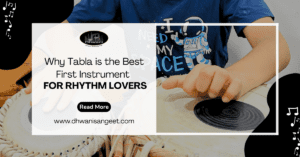
The tabla is an integral part of classical music and is a melodious percussion instrument that has its roots of origin way back in time. The mention of tabla can be found in centuries-old Sanskrit scriptures that elaborately mention the ancient history of various musical instruments like tabla. These mentions represent the association of tabla with the glorious history of Indian classical music.
These textual representations and evidence also indicate the fact that the instrument was more popular and vividly used in the northern part of the Indian subcontinent than in the southern part of India. With time it also got interlinked with classical dance forms like Kathak, Bharatnatyam, Odissi, etc., and eventually became an integral part of their performance, practice, and recitals. Moreover, tabla has developed an integral accompaniment with north Indian dance forms, especially Kathak, where the Taals of Kathak and the Tabla go hand in hand.
The connections of tabla can also be traced to Persia as well as Central Asia and their rich cultures. Moreover, some Indian mythological texts and stories also associate tabla with ‘Pakhawaj’, the instrument allegedly played by Lord Ganesha. According to mythological beliefs, Ganesha once dropped the Pakhawaj while playing it and it led to the birth of tabla. Hence, in some parts, tabla is also believed to have come out of Pakhawaj, as its lighter version.
After having briefly discussed the roots of the origin of the Tabla, let us proceed further to understand the anatomy of the tabla in a detailed manner.
Tabla and It’s Anatomy
As we know, the tabla is a set of two percussion drums, the “Dayan” or Treble drum, and the “Bayan” or the Bass drum. As the names suggest, Dayan, which is the smaller drum, is meant to be played with the dominant hand i.e. the right hand, and the Bayan, the larger among the two, with the non-dominant or the left hand. Interestingly, the Dayan is made of wood and produces high-pitched sounds, while the Bayan is made of clay or metal and produces a deeper bass or sound. The upper face of the tabla, which is tapped with hands to produce the melodious rhythms and vibrations, is made of animal skin, which is commonly goat skin and is tied and secured to the body of the tabla with the help of leather straps. Seasoned tabla manufacturers understand the importance of choosing good quality skin that is neither too hard nor too soft, to keep the tabla safe from the effects of harsh weather conditions. Moreover, the middle black portion present on the surface of the tabla is made from ‘Shyahi’, which is a combination of iron, rice paste, water, and a specific type of clay which helps produce a metallic tone at the center. The Shyahi renders distinct qualities to the tabla to produce specific rhythms and sounds that remain unmatched by any other percussion instrument in the world. A professional or good-quality tabla is made either from Sheesham wood, Neem wood, or Mahogany wood. However, the tabla made of Sheesham wood is considered to be of superior quality and is preferred by musicians and tabalchis. Noteworthily, the tune of the tabla can also be adjusted according to one style, preference, or liking, by moving the eight ‘Gattas’ present around the membrane. These Gattas help adjust the tightness or tension of the membrane to produce the desired sounds.Techniques, Styles, and Gharanas related to the Tabla
There are various techniques and hand gestures that are used to produce different ‘taal’ or ‘bol’ from the tabla. These techniques are a combination of intricate rhythmic patterns, hand movements, and finger placements. These techniques are used to produce various sounds like Na, (or the single stroke), Ta (double stroke), Dhin, Dhin, Tin, and so on. There are numerous tabla compositions that are attributed to the signature style of the various tabla ‘Gharanas’. The four tabla gharanas that have imbued this art with their individual intricacies, distinctness, and characteristics include Punjab, Ajrada, Delhi, and Lucknow Gharana. These gharanas have greatly contributed to shaping, nurturing, and taking forward the fine art of playing the tabla so much so that even to this day and beyond, the tabla has secured an inseparable position and the center stage in the realm of Indian classical music. Interestingly, the melodies of tabla are not bound to the classical genre but are increasingly finding their place in other prominent genres like western, pop, and fusion to create unparalleled ‘Jugalbandis’. Now let us move further and highlight some lesser-known as well as intriguingly interesting facts about the tabla.Interesting Things to Know about the Tabla
- Many researchers believe that the history of classical music in India is around 5000 years old and the clear mentions and evidence related to the origin of tabla can be found in the 18th century.
- There are various stories and beliefs that support the fact that the tabla originated from Pakhawaj, the ancient barrel-shaped two-faced percussion instrument.
- Another interesting story behind the origin of the tabla suggests that the tabla originated as a result of competition and a fight between the two pakhawaj players of the Mughal court. The saying suggests that after the competition between Mohammed Shah and Sidar Khan, the latter cut the pakhawaj with his sword into two parts, leading to the birth of what we know today as the Tabla.
- Another interesting legend related to the invention of the tabla suggests that it was invented by Amir Khusro, in the first half of the 18th century, specifically to accompany his ‘Khayal’ gayaki.


